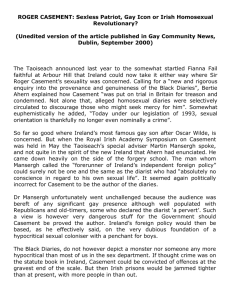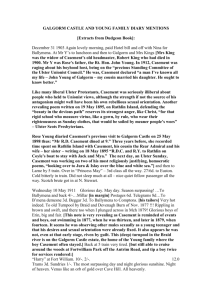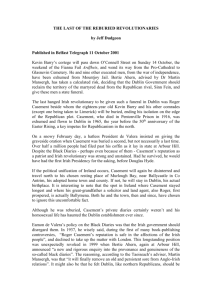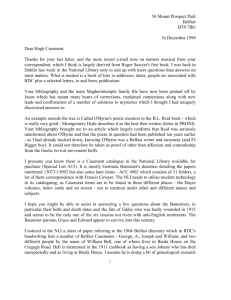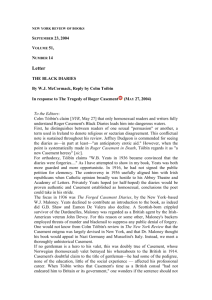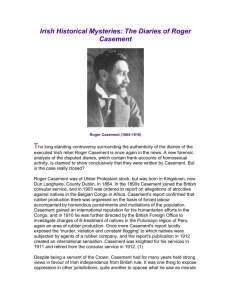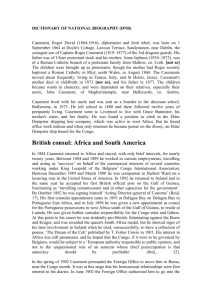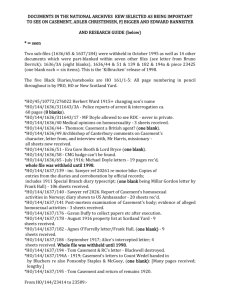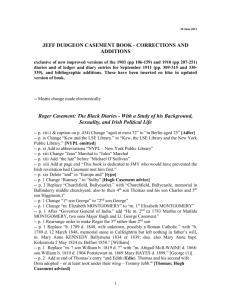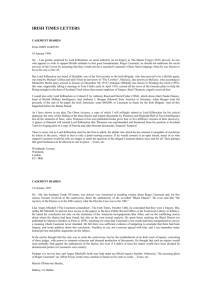To Stephen Mulkearn
advertisement
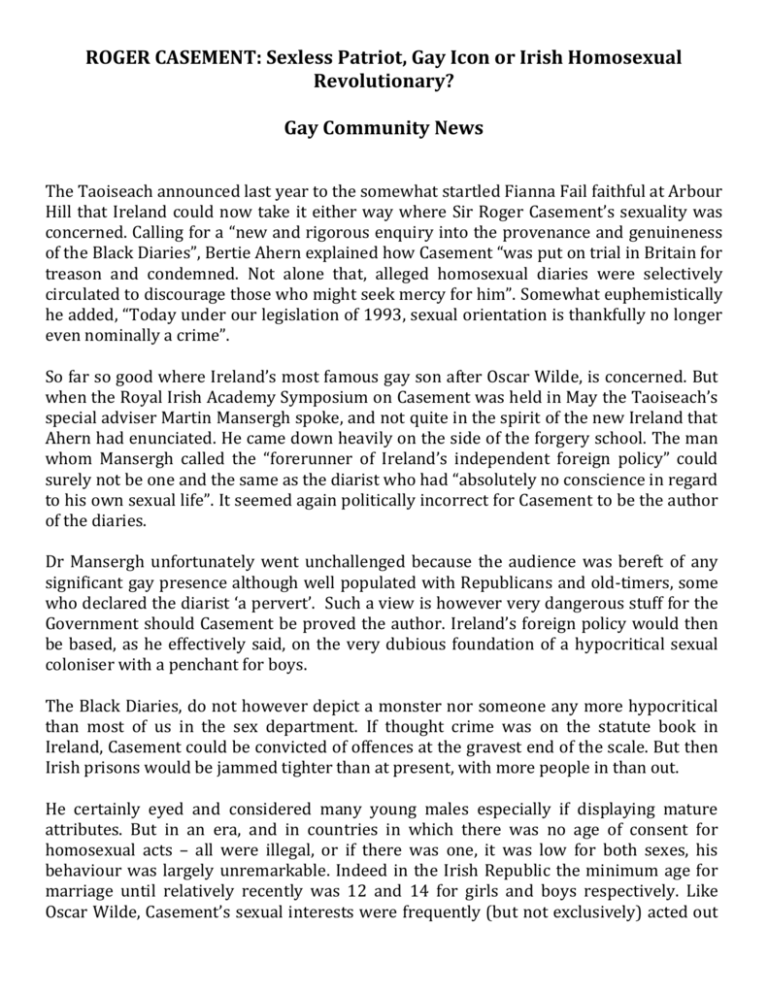
ROGER CASEMENT: Sexless Patriot, Gay Icon or Irish Homosexual Revolutionary? Gay Community News The Taoiseach announced last year to the somewhat startled Fianna Fail faithful at Arbour Hill that Ireland could now take it either way where Sir Roger Casement’s sexuality was concerned. Calling for a “new and rigorous enquiry into the provenance and genuineness of the Black Diaries”, Bertie Ahern explained how Casement “was put on trial in Britain for treason and condemned. Not alone that, alleged homosexual diaries were selectively circulated to discourage those who might seek mercy for him”. Somewhat euphemistically he added, “Today under our legislation of 1993, sexual orientation is thankfully no longer even nominally a crime”. So far so good where Ireland’s most famous gay son after Oscar Wilde, is concerned. But when the Royal Irish Academy Symposium on Casement was held in May the Taoiseach’s special adviser Martin Mansergh spoke, and not quite in the spirit of the new Ireland that Ahern had enunciated. He came down heavily on the side of the forgery school. The man whom Mansergh called the “forerunner of Ireland’s independent foreign policy” could surely not be one and the same as the diarist who had “absolutely no conscience in regard to his own sexual life”. It seemed again politically incorrect for Casement to be the author of the diaries. Dr Mansergh unfortunately went unchallenged because the audience was bereft of any significant gay presence although well populated with Republicans and old-timers, some who declared the diarist ‘a pervert’. Such a view is however very dangerous stuff for the Government should Casement be proved the author. Ireland’s foreign policy would then be based, as he effectively said, on the very dubious foundation of a hypocritical sexual coloniser with a penchant for boys. The Black Diaries, do not however depict a monster nor someone any more hypocritical than most of us in the sex department. If thought crime was on the statute book in Ireland, Casement could be convicted of offences at the gravest end of the scale. But then Irish prisons would be jammed tighter than at present, with more people in than out. He certainly eyed and considered many young males especially if displaying mature attributes. But in an era, and in countries in which there was no age of consent for homosexual acts – all were illegal, or if there was one, it was low for both sexes, his behaviour was largely unremarkable. Indeed in the Irish Republic the minimum age for marriage until relatively recently was 12 and 14 for girls and boys respectively. Like Oscar Wilde, Casement’s sexual interests were frequently (but not exclusively) acted out with teenagers. Yet nobody today in Dublin would even dare say that Wilde should still have been jailed and discredited for his ‘under-age’ sexual acts. Casement was no saint and some of his activities do give cause for concern but he normally did not exploit people and he was no sexual coloniser. The partners he described were urbanised, usually eager, and certainly consenting males of many races and nationalities. Despite Martin Mansergh’s view that the diarist was “as predatory towards the natives as those he criticised”, as one who wrote in his private journal of fondling testicles nobody should put Casement in the same category as the Peruvian criminal, Armando Normand whom he accused of smashing Indians’ testicles for pleasure. It is important also to point out that the diaries do not depict sex with forest Indians on the Amazon nor with Africans in the jungle, people who might be categorised as ‘natives’, and especially not when as Consul he was undertaking humanitarian investigations. The following South American samples from the unpublished 1911 diary of his cruising (and musing), his sexual enthusiasms and his somewhat dubious seduction technique (with José) are typical of that year. The two Irish samples come from the 1911 Cashbook: 5 March 1911 (in Dublin) “How”? 2/6 X Enormous 19 - about 7" and 4" thick. X ...Supper at Jury's ...Enormous Dublin under 19. Very fair, thin leg knickers & coat, white scarf. Blue eyes & huge huge stiff, long & thick - a limb. 11 May 1911 (in Belfast) Glorious day....Swimming bath 3d...Saw the man, a glorious type get in Belfast. Fair hair and blue eyes and tall strong, well dressed at [Castle] "Junction". He looked and smiled and felt again and again. To Swimming Bath and four Beauties...Harry 10/- X ...at Northern Railway Company. 4 September 1911 (in Bridgetown, Barbados): “Then to bathe and met Stanley Weeks 20 years. Has certificate from Trinidad Electrical concern - trying to get work here at the Electrical. Bathed together first 9 a.m. Huge one and then 12.45: Huger still. Hung down curved and swollen, and wanted awfully. Poor boy. Wished I had taken him. Will try and get him to Iquitos. Was waiter once in a B'bados Hotel. Two scars on face from fall. One on thigh too.” 18 September 1911 (in Pará, Brazil): “I waited for two trams to pass and then walked along and was looking back at a lovely caboclo sailor when a moco hurried over and held out his hand and it was this boy. He had followed - at once took my arm and squeezed and led away side - and arranged meet at Nazareth Square at 8. To Dickey, ill, and then to Nazareth & at 8.15 he came and at once led me off. Felt, huge - thick as wrist - only 17 or 18. From Lisbon. 4 years in Pará. Walked to Sao Braz. he squeezing hand and wrist all time and then "assenta!" [‘sat down’] on grass in dark lane he admitted his wish at once and so I took it. First spittle but so big could not get in - then glycerine honey and in it went with huge thrust and he sunk on me and worked hard.” 25 November 1911 (in Iquitos, Peru): “José came at 8.10 - sat down beside me with coat off and we started Spanish exercises - my hand on "muscles" and I felt it often. Then got him to stand against wall and to measure, and it was up, and I put my hand on it often and felt it swelling and stiff. He wanted awfully blushing and loving and gleaming eyes. Sitting again - it up huge and I played with it.” Of course Casement was the author. Nobody forged the diaries. The evidence adduced in that direction falls down on close inspection; worse it changes when challenged and the assertions becomes wilder and the alleged forger’s name ever more unlikely as the saga progresses. The sad truth is that the question has little or nothing to do with the diaries or homosexuality, and everything to do with blaming somebody, in this case the usual culprit the Brits. A new modernist argument purveyed by Angus Mitchell editor of Amazon Journal is that the writer was so frightful an exploiting paedophile that the diaries are actually a homophobic concoction. This requires us to believe that a forger went to British Naval Intelligence in 1916 and reported in as a highly experienced homosexual ready to do his duty for King and Country by writing and researching more than a thousand daily diary entries detailing a great deal of rampant sexual activity alongside innumerable other incidents and characters (many famous). To deal with this farrago of nonsense I am editing in abridged, annotated form all five diaries (including the never-before seen, sexually raw, 1911 item) within a forthcoming biography. This book as well as dealing with the authenticity dispute, Casement’s homosexuality (for which there is extensive hidden evidence) and his best known companions (including one, Millar Gordon from Belfast and the Norwegian sailor Adler Christensen) will major on his family background in Co. Antrim and his involvement in Irish politics from 1904-16. I have also unearthed a great deal of new material that overturns a number of key beliefs about Casement, a man whose illustrious career was undoubtedly influenced and may even have been driven by his homosexual status. In every previous decade since the execution in August 1916 the controversy surrounding the Black Diaries has provoked a stream of correspondence in the news columns of the Dublin newspapers - especially when a new book on Casement has been published or new papers released. He remains the most written about leader of the Easter Rising largely because he was charismatic and wrote highly sexualised diaries but also because of his key diplomatic and revolutionary activities. He was at the same time an enigma, being a British diplomat knighted for his investigations into rubber slavery in the Congo and Amazon, and an initiating gun runner (twice) on behalf of Oglaigh na hEireann (then named in English the Irish Volunteers). A committed Irish revolutionary he was an Ulster Protestant. Or was he? Landing off a German submarine on Good Friday 1916 he was captured, hustled to London and executed after a trial in which there could only have been one verdict. To discredit him and stave off a campaign for clemency, pages of the diaries were shown to journalists and to American politicians. Despite such potential for controversy the usual blizzard of claims and counter claims did not occur this year. The issue seemed killed stone dead although RTE Radio 1 did devote a series of programmes to the Casement Symposium in the summer (ignoring this writer the only up-front gay person on the platform) the Irish Times declined to publish any letters dealing with Dr Mansergh’s claims or other aspects. The silence is all the more mysterious as an effort is obviously being made from the very top of Irish government to reposition the Casement controversy. Almost unremarked, the generally held view, certainly in academic and intellectual circles since the late 1950’s that the diaries were genuine, is being revised and discreetly supplanted. Casement is not being permitted his homosexual history - just when it is no longer a vice or sin, rather the opposite. But is he a gay icon? “...Greta Garbo and Monroe Dietrich and DiMaggio Marlon Brando, Jimmy Dean On the cover of a magazine Roger Casement, Harlow Jean...” Well no. It’s Grace Kelly not Roger Casement in Madonna’s song Vogue and it was Rita Hayworth, as she sang, who “gave good face”. Nonetheless one of the complaints of the forgery school is that homosexuals are trying to turn Casement into a gay icon. This unwarranted assertion infers that gay men are, as a class, historically minded. The notion that Casement has a cult following like James Dean, Marilyn Monroe or even Princess Diana is laughable. Just mention in Dublin’s gay pub The George, as I have done, that you are doing research on the man and you are met with entirely blank looks from anyone who is not a history or politics buff. In Belfast, Casement Park registers, but Catholic and Protestant are united in their ignorance of the man it was named after. The only cult created around Casement was of a Catholic nationalist nature, one that saw him as a double martyr, first hanged and then with his reputation vilified. In these new times we can however rescue his reputation by telling the truth about an often good gay. Biographical note: Jeff Dudgeon is Treasurer of NIGRA and was the successful plaintiff at the European Court of Human Rights in Strasbourg against the British Government which led to the decriminalisation of homosexuality in Northern Ireland. August 2000 jeffreydudgeon@hotmail.com 56 Mount Prospect Park Belfast BT9 7BG
